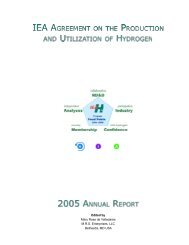Technology Status of Hydrogen Road Vehicles
Technology Status of Hydrogen Road Vehicles
Technology Status of Hydrogen Road Vehicles
Create successful ePaper yourself
Turn your PDF publications into a flip-book with our unique Google optimized e-Paper software.
Cleghorn, S., et al., “PEM Fuel Cells for Transportation and Stationary Power Generation<br />
Applications,” Los Alamos N.L., New Mexico, USA, pp. 1637-1646.<br />
This paper describes LANL’s efforts to develop a low cost/high performance hydrogen or reformate air stack,<br />
based on ultra-low Pt loadings and on non-machined inexpensive elements for flow fields and bi-polar plates.<br />
On-board methanol reforming is compared to direct methanol FCs in light <strong>of</strong> significant power density<br />
increases <strong>of</strong> the latter.<br />
The achievements so far are:<br />
! Thin-film catalyst layer application gives ultra-low Pt loadings <strong>of</strong> 0.2 g/kW, which in 5,000-h tests<br />
produced 6 kW/m 2 using pressurized H 2/air<br />
! Off-the-shelf stainless steel screens as flow fields, in place <strong>of</strong> the expensive machined metal ones normally<br />
used, showed relatively good performance;<br />
! A significant increase in CO tolerance at anode to >>100 ppm with reformed hydrocarbon<br />
! The record high performance <strong>of</strong> polymer electrolyte direct methanol FCs with Nafion as hot as 130ºC,<br />
already achieved by Siemens, has been repeated, and the future <strong>of</strong> this FC is promising provided that<br />
catalyst loadings can be further reduced or changed, long-term stable performance is demonstrated, and<br />
that methanol cross-over to the cathode can be minimized to acceptable levels.<br />
The authors feel that commercialization is likely to occur for stationary applications first, because <strong>of</strong> less<br />
stringent requirements on overall cost, space, and nature/source <strong>of</strong> the H 2 fuel; the PEM FC, even in relatively<br />
small sizes by comparison with molten carbonate or solid oxide FCs, could be attractive in some applications<br />
such as peak power, demand-side management, and dispersed power generation.<br />
Mantegazza, C.; A. Maggiore, “PEFC Activities at DNP,” De Nora, Milan, Italy, pp. 1647-1656.<br />
This paper is a review <strong>of</strong> the work since 1990 developing 5- and 10-kW PEM FCs, especially for the bus <strong>of</strong><br />
Item 6 Table 1 and the car <strong>of</strong> Item 9 Table 2.<br />
The present approach is to develop a metallic material for the stack structure with good crash resistance, lowcost<br />
production potential, corrosion resistance, commercial availability, and recyclability, compared to the<br />
precise and delicate materials used so far.<br />
The first 5-kW unit had low power density <strong>of</strong> 40 W/kg, easily improved to about double by going to lowvoltage,<br />
high-current stack design; so far >6000 h in 40 units <strong>of</strong> various sizes have been accumulated.<br />
A small (0.5-kW) unit with reformed methanol containing 500 ppm CO has also been successfully<br />
demonstrated.<br />
The 10-kW prototype for Item 9 Table 2 was tested in January 1996 at 100 W/kg.<br />
By 1999, a 250-W/kg unit is foreseen, and stack selling prices should drop to $600/kW, opening commercial<br />
possibilities, at least in the stationary field.<br />
Barbir, F., “Control Strategy for a Vehicular Fuel Cell Power System,” Energy Partners, Florida, USA,<br />
pp. 1695-1705.<br />
As part <strong>of</strong> the FC car development <strong>of</strong> this company (Item 13 Table 1), various control strategies have been<br />
simulated.<br />
64













